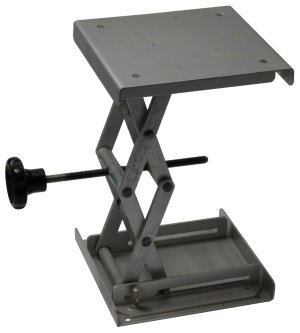Focusing jackA means of moving the camera back and forth in small increments is essential in close-up and macro photography. Focusing racks accomplish this, and are the best choice in the field. However, in the laboratory, especially when one takes pictures with the camera suspended vertically above the subject, a focusing jack can be a good alternative or complement. 


A laboratory jack is a platform that can be adjusted in height by turning a knob. The most common design employs a scissor-like or pantograph-like mechanism to achieve this. In the laboratory, jacks often are used to change the height of burners or large glass containers. They offer a continuously variable range of heights, typically between roughly 5 and 20 cm. Thus, they equal or exceed the travel distance of a normal focusing rack). Provided that the mechanisms of a laboratory jacks move smoothly and with sufficient precision, this apparatus can be used to focus a subject placed on its platform under a vertically suspended camera. This is practical as long as the subject is not excessively large or heavy. Laboratory jacks with a platform approximately 10 by 10 to 20 by 20 cm are optimal for this use. Smaller ones tend to be unsteady, and their mechanisms imprecise. Larger ones may change their height too rapidly to allow precise focusing. The cheapest laboratory jacks may be too imprecise and wobbly, and second-hand ones often are rusty or worn out. The sliding mechanisms require lubrication with solid fat to prevent uneven movements and wear on metal-to-metal surfaces. Laboratory jacks of adequate quality for use as focusing jacks are relatively inexpensive, and significantly cheaper than a good focusing rack. When testing a laboratory jack in a shop, make sure that movements of the platform and knob are smooth and unimpeded, and that joints are not excessively stiff. First, check whether you can increase the height of the platform smoothly by turning the knob without exerting much force. Then, reverse the direction of rotation of the knob, and check that the platform lowers smoothly without etting temporarily stuck at the same height. If this happens, place a moderate weight - not more than half a kg - on the platform, and try again. If the platform now reverses its direction smoothly, you should not have have a problem with this jack once it is properly lubricated. Repeat this procedure at different heights of the platform. If the platform consistently gets stuck or visibly changes its inclination when you reverse direction, choose another jack. Movement will get much smoother once the joints and screw are properly lubricated with molybdenum fat, but mechanical defects cannot be corrected by simple lubrication. Check also that joints and sliding guides are not so loose that the top and bottom platform have a propensity to wobble. A small amount of play, however, is acceptable (after all, these jacks are not meant to be precision machinery, and you will not be touching the jack while the actual camera exposure takes place). There is a type of laboratory jack similar to the one illustrated above, except for having wheels that press against the top and bottom platform, instead of pegs sliding within horizontal guides. Beware of this type of mechanism. If in doubt, check that the top and bottom platforms cannot be rotated away from the scissor mechanism by pulling them gently outwards. If they can, choose a different model. You do not want a jack with top and bottom platforms that easily topple and catapult away the subject you are photographing. A drawback of scissor-type laboratory jacks is that, for the same number of turns of the knob, height of the platform increases more rapidly when the jack height is low, and more slowly when the jack is almost fully extended. In addition, movement of the platform is likely to be more uneven near the two extremes of height. Therefore, it is a good idea to use a jack for focusing, whenever feasible, within an interval of roughly 1/4 and 3/4 of its maximum height. There are also high-precision jacks of a similar design, built for use on optical benches, and if you are fortunate enough to obtain one below cost, it will make a wonderful focusing attachment. Buying a new one, however, is going to cost you far more than a good focusing rack.  Laboratory jacks are not designed for use as focusing attachments. Therefore, they may require simple modifications for this purpose. The jack illustrated above, for instance, has had three hard rubber feet added at its bottom to make it steadier (the adjustable knob in one corner acts as a fourth foot), and a black plastic sheet glued onto the top surface, to cut reflection and glare. |